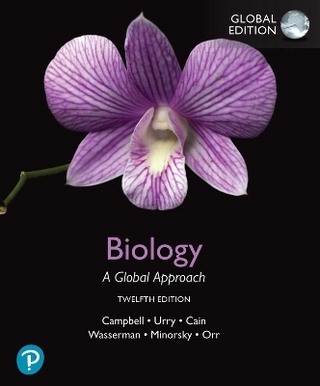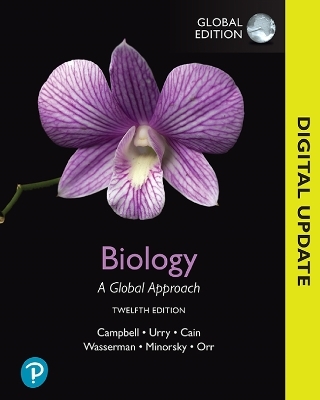
Pearson eText Biology
Pearson (Hersteller)
978-0-13-524292-6 (ISBN)
- Titel erscheint in neuer Auflage
- Artikel merken
For non-majors/mixed biology courses.
Pearson eText is a simple-to-use, mobile-optimized, personalized reading experience. It allows students to highlight, take notes, and review key vocabulary all in one place, even when offline. Seamlessly integrated videos and other rich media engage students and give them access to the help they need, when they need it. Educators can easily schedule readings and share their own notes with students so they see the connection between their eText and what they learn in class – motivating them to keep reading, and keep learning. And, reading analytics offer insight into how students use the eText, helping educators tailor their instruction.
NOTE: This ISBN is for the Pearson eText access card. For students purchasing this product from an online retailer, Pearson eText is a fully digital delivery of Pearson content and should only be purchased when required by your instructor. In addition to your purchase, you will need a course invite link, provided by your instructor, to register for and use Pearson eText.
TERRY AND GERRY AUDESIRK grew up in New Jersey, where they met as undergraduates. After marrying in 1970, they moved to California, where Terry earned her doctorate in marine ecology at the University of Southern California and Gerry earned his doctorate in neurobiology at the California Institute of Technology. As postdoctoral students at the University of Washington’s marine laboratories, they worked together on the neural bases of behavior, using a marine mollusk as a model system. They are now emeritus professors of biology at the University of Colorado Denver, where they taught introductory biology and neurobiology from 1982 through 2006. In their research, funded primarily by the National Institutes of Health, they investigated the mechanisms by which neurons are harmed by low levels of environmental pollutants and protected by estrogen. Terry and Gerry share a deep appreciation of nature and of the outdoors. They enjoy hiking in the Rockies, walking near their home in Steamboat Springs, and attempting to garden at 7,000 feet in the presence of hungry deer and elk. They are long-time members of many conservation organizations. Their daughter, Heather, provides another welcome focus to their lives. BRUCE E. BYERS is a midwesterner transplanted to the hills of western Massachusetts, where he is a professor in the biology department at the University of Massachusetts, Amherst. He’s been a member of the faculty at UMass (where he also completed his doctoral degree) since 1993. Bruce teaches introductory biology courses for both nonmajors and majors; he also teaches courses in ornithology and animal behavior. A lifelong fascination with birds ultimately led Bruce to scientific exploration of avian biology. His current research focuses on the behavioral ecology of birds, especially on the function and evolution of the vocal signals that birds use to communicate. The pursuit of vocalizations often takes Bruce outdoors, where he can be found before dawn, tape recorder in hand, awaiting the first songs of a new day.
1. An Introduction to Life on Earth
Unit 1: THE LIFE OF THE CELL
2. Atoms, Molecules, and Life
3. Biological Molecules
4. Cell Structure and Function
5. Cell Membrane Structure and Function
6. Energy Flow in the Life of a Cell
7. Capturing Solar Energy: Photosynthesis
8. Harvesting Energy: Glycolysis and Cellular Respiration
Unit 2: INHERITANCE
9. Cellular Reproduction
10. Meiosis: The Basis of Sexual Reproduction
11. Patterns of Inheritance
12. DNA: The Molecule of Heredity
13. Gene Expression and Regulation
14. Biotechnology
Unit 3: EVOLUTION AND DIVERSITY OF LIFE
15. Principles of Evolution
16. How Populations Evolve
17. The Origin of Species
18. The History of Life
19. Systematics: Seeking Order Amid Diversity
20. The Diversity of Prokaryotes and Viruses
21. The Diversity of Protists
22. The Diversity of Plants
23. The Diversity of Fungi
24. Animal Diversity I: Invertebrates
25. Animal Diversity II: Vertebrates
Unit 4. BEHAVIOR AND ECOLOGY
26. Animal Behavior
27. Population Growth and Regulation
28. Community Interactions
29. Energy Flow and Nutrient Cycling in Ecosystems
30. Earth’s Diverse Ecosystems
31. Conserving Earth’s Biodiversity
Unit 5. ANIMAL ANATOMY AND PHYSIOLOGY
32. Homeostasis and the Organization of the Animal Body
33. Circulation
34. Respiration
35. Nutrition and Digestion
36. The Urinary System
37. Defense Against Disease
38. Chemical Control of the Animal Body: The Endocrine System
39. The Nervous System
40. The Senses
41. Action and Support: The Muscles and Skeleton
42. Animal Reproduction
43. Animal Development
Unit 6. PLANT ANATOMY AND PHYSIOLOGY
44. Plant Anatomy and Nutrient Transport
45. Plant Reproduction and Development
46. Plant Responses to the Environment
Biology Life on Earth, Eleventh Edition includes Chapters 1–30
Biology Life on Earth with Physiology, Eleventh Edition includes Chapters 1–46
| Sprache | englisch |
|---|---|
| Themenwelt | Naturwissenschaften ► Biologie |
| ISBN-10 | 0-13-524292-4 / 0135242924 |
| ISBN-13 | 978-0-13-524292-6 / 9780135242926 |
| Zustand | Neuware |
| Informationen gemäß Produktsicherheitsverordnung (GPSR) | |
| Haben Sie eine Frage zum Produkt? |
aus dem Bereich


